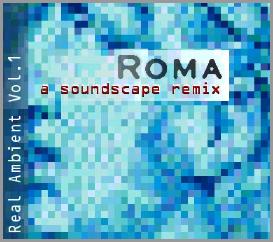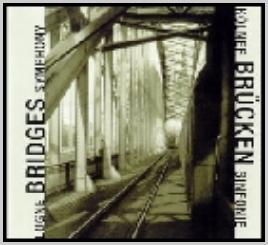from: The Wire, 5/2000
MICHAEL RÜSENBERG Cologne Bridges Symphony (Artelier Music/Noteworks NW5102CD)
VARIOUS ARTISTS Roma - A Soundscape Remix

„Roma - A Soundscape Remix“ and the „Kölner Brücken Sinfonie“ are the first two volumes in a new so-called „Real Ambient“ series from Artelier Music. Real Ambient appears to offer a means of reconnecting the escapist and technophile vistas of much Ambient music with a more directly human reality. Both the releases so far in the series comprise music composed entirely from urban environmental recordings, although they are very different experiences.
Michael Rüsenberg recorded the city soundscape in Rome between 1994 and 1997, composing the dramatic and fascinating ”Roma Modulare” from the results. The piece works equally with steady evolutions of sounds and with sharp, sudden contrasts, and its churches, traffic and people are blended with expertise and sensitivity. ”Roma Modulare” is included on A Soundscape Remix alongside eight widely varying remixes, offering a broad range of avenues that future soundscapers might wish to pursue.
Agostino Di Scipio, an electronic music professor, offers one of the most radical reworkings, using timestretching to speed and slow segments of the original beyond recognition, all structured very formally and mathematically. The result, however, is surprisingly informal, emphasising grains of noise in the city sound that would otherwise be inaudible, retaining something of the material‘s character while remaining totally abstract. ”Untitled „#80” is Francisco Lopez‘s attempt to strip away the representational and documentary aspects in favour of a pure sound approach, but his enormously reverberating wash of ambience is considerably less interesting, largely due to the lack of that very local character. Christoph Haberer‘s contribution is the least successful. His background as a jazz drummer sees him intercut soundscape samples with highly rhythmic melodies, with a banal, synthetic timbre. Lisa Kucharski‘s metronomic sonic staccato is a more successful rhythm—based cu t-up, while David Toop‘s view of the city as paranoid, compressed and alienated also has great individuality. Christoph Korn adopts electronica‘s colours to create a more blissful Roman fantasy, while others stick to Rüsenberg‘s own montage-based strategy. The album overall provides a thought-provoking cross section of approaches, from the most abstract to the more documentary, and as a result it‘s way ahead of some of the more pofaced and uncommunicative examples of the environmental soundscaper‘s art.
 Cologne Bridges Symphony is altogether more focused, with no one given the opportunity to subvert Rüsenberg‘s own methodology. Although fairly singular in concept, it certainly isn‘t the first attempt to create music from the marriage of microphone and massive engineering structures. John Hudak‘s 1998 Brooklyn Bridge miked up Washington Roebling‘s masterpiece, taking the bridge‘s fine web of suspension cables as inspiration for a shimmering, ethereal haze of sound, which, by dint of processing, virtually obliterated all trace of the bridge itself.
Cologne Bridges Symphony is altogether more focused, with no one given the opportunity to subvert Rüsenberg‘s own methodology. Although fairly singular in concept, it certainly isn‘t the first attempt to create music from the marriage of microphone and massive engineering structures. John Hudak‘s 1998 Brooklyn Bridge miked up Washington Roebling‘s masterpiece, taking the bridge‘s fine web of suspension cables as inspiration for a shimmering, ethereal haze of sound, which, by dint of processing, virtually obliterated all trace of the bridge itself.
Rüsenberg‘s ‘symphony‘ is a major contrast, with most of the
environmental sounds remaining recognisable. Noises include the hum of wind and traffic, the resonant throb of vibrating deck plates, the creak of stressed steel and regular clattering as traffic traverses the bridge‘sjoints. If someone were to add an unhealthy dose of reverb and delay, much of the album wouldn‘t seem out of pla ≠ce on some murky compilation of isolationist Ambient music. With those effects left sensibly switched oft, what results is a far more concrete, far more imaginative depiction of the alien world that metals might experience if they came alive. As on ”Roma Modulare”, Rüsenberg retains a very fine ear for structure and for the richness of his sounds. Here he shows an additional ability to pursue unexpected diversions. On one track, ”Südbrücke”, bridge sounds are combined with fragmentary recital of a text about the Cologne bridges, then supplemented by the inexplicable addition of somebody singing ”My Funny Valentine” — if it‘s odd, it‘s the oddness of a visionary.
BRIAN DUGUID




